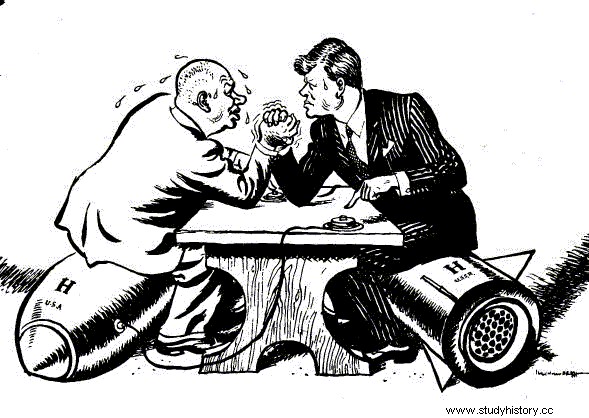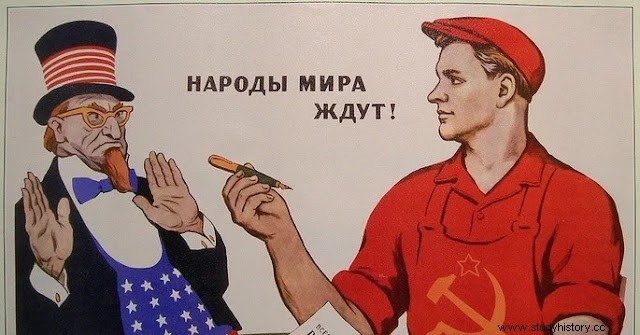Question 02 - FACASPER 2018 - The cartoon on the side was published in 1962 and represents the so-called “Missile Crisis” that occurred between the Soviet Union and the United States in that same year. In the illustration, both countries are represented by their leaders, respectively, Nikita Khrushchev and John F. Kennedy.
 Source:http://www.johndclare.net/cold_war16.htm | Access:10/14/2017. About the “Missile Crisis”, it is correct to say:a) It was triggered when it became known that the Soviet Union had carried out its first test with the hydrogen bomb, or “H bomb”, and Kennedy accused the Soviets of spying on the Americans to discover secrets about the weapon's operation. b) It began when the Soviet intelligence service discovered that the United States was building new bases for launching nuclear missiles, which was contrary to the agreement signed by Kennedy and Khrushchev the previous year, in Paris. c) It stemmed from Khrushchev's decision to supply Mao-Tse-Tung's China with the technology for building long-range missiles, with which the Chinese could also hit the United States with nuclear weapons in the event of war. d) It began when the US government discovered that the Soviet Union was building a missile launch base in Cuba, which led to a confrontation between Kennedy and Khrushchev and the prospect of a war to be fought with nuclear weapons. e) It represented the height of the Cold War because, while the United States and the Soviet Union denied having nuclear missiles, they secretly competed for the construction of a greater number of launch bases for such missiles.
Source:http://www.johndclare.net/cold_war16.htm | Access:10/14/2017. About the “Missile Crisis”, it is correct to say:a) It was triggered when it became known that the Soviet Union had carried out its first test with the hydrogen bomb, or “H bomb”, and Kennedy accused the Soviets of spying on the Americans to discover secrets about the weapon's operation. b) It began when the Soviet intelligence service discovered that the United States was building new bases for launching nuclear missiles, which was contrary to the agreement signed by Kennedy and Khrushchev the previous year, in Paris. c) It stemmed from Khrushchev's decision to supply Mao-Tse-Tung's China with the technology for building long-range missiles, with which the Chinese could also hit the United States with nuclear weapons in the event of war. d) It began when the US government discovered that the Soviet Union was building a missile launch base in Cuba, which led to a confrontation between Kennedy and Khrushchev and the prospect of a war to be fought with nuclear weapons. e) It represented the height of the Cold War because, while the United States and the Soviet Union denied having nuclear missiles, they secretly competed for the construction of a greater number of launch bases for such missiles.Question 03 - UFTM 2013/2 - Officially, the world did not wake up to the Cuban Missile Crisis until the evening of Monday, October 22, 1962, when President [John] Kennedy first spoke on television to announce the presence of Soviet missiles in Cuba. and declare its intention to impose a naval blockade. [...] For the first time since the United States dropped atomic bombs on Hiroshima and Nagasaki in 1945, hundreds of millions of people across the globe feared that nuclear weapons might be used again. (Richard Gott. Cuba:Uma Nova História, 2006.)
The text refers to the so-called “Cuba missile crisis”, a) beginning of the trade embargo and the US military blockade against Cuba, strategies of political and commercial isolation from the island that persist to this day. b) consummation of the success of the Cuban Revolution, with the overthrow of the pro-Soviet regime and the reestablishment of US control over Cuban sugar production. c) moment of political tension that defined the end of US hegemony over the Caribbean and Central America and increased Soviet influence in the region. d) starting point for a new form of diplomatic and political relations between the United States and Latin America, as it started a cycle of social revolutions on the continent. e) central episode of the Cold War and demonstration of the North American effort to maintain its hegemony over Latin America after the Cuban Revolution.
Question 04 - UNICID 2013 - Speaking to the entire country tonight, on national radio and television, President John F. Kennedy announced that the United States will no longer allow the Soviet Union to continue increasing its offensive arsenal in Cuba, as this represents serious threat to the nations of this hemisphere. (O Estado de S.Paulo, 10.23.1962. Adapted.) After the end of the Second World War there was a bipolarization of the world geographic space with the formation of two blocks:one led by the United States (capitalist) and the other by the Soviet Union (socialist). Known as the Cold War, this period was characterized by political, ideological and military hostilities between these superpowers, as reported by the report published in 1962. The report refers to a) Missile Crisis. b) Korean War. c) Cuban Revolution. d) Vietnam War. e) Decolonization of Africa.
Question 05 - Look closely at the poster below:Text 1
 |
| "The peoples of the world are waiting for disarmament and peace." V. Govorkov, 1962. |
Text 2
The Missile Crisis, in October 1962, was the moment when the United States and the Soviet Union were closest to a nuclear conflict. President Kennedy made a national televised address to inform the public about the unfolding situation in Cuba, his decision to place this country in “quarantine” and the global consequences if the crisis continued. “It will be the policy of this nation to regard any nuclear missile launched from Cuba against any nation in the Western Hemisphere as an attack by the Soviet Union on the United States, requiring a full retaliatory response against the Soviet Union.” (Adapted:https://history.state.gov/milestones/1961-1968/. Retrieved 12.08.2020). About the Missile Crisis it is correct to say:a) It was a diplomatic conflict where the Soviet Union was willing to give in its positions much more than the United States, as portrayed in the poster above. b) It was a political-military maneuver that the United States circumvented, through diplomacy and the UN Council, without having to resort to military threats. c) Kennedy's speech on television belies the above poster, as it shows that the American president was also thinking of finding a peaceful solution to the confrontation. d) The impasse was resolved with cessions from both parties:the Soviets did not place missiles in Cuba and the Americans withdrew medium-range weapons from the base they had in Turkey.> 01 - E02 - D03 - E04 - A05 - D
